Entrepreneurial Ventures Assignment
VerifiedAdded on 2021/01/01
|15
|4527
|344
AI Summary
Contribute Materials
Your contribution can guide someone’s learning journey. Share your
documents today.

ESBM
Secure Best Marks with AI Grader
Need help grading? Try our AI Grader for instant feedback on your assignments.
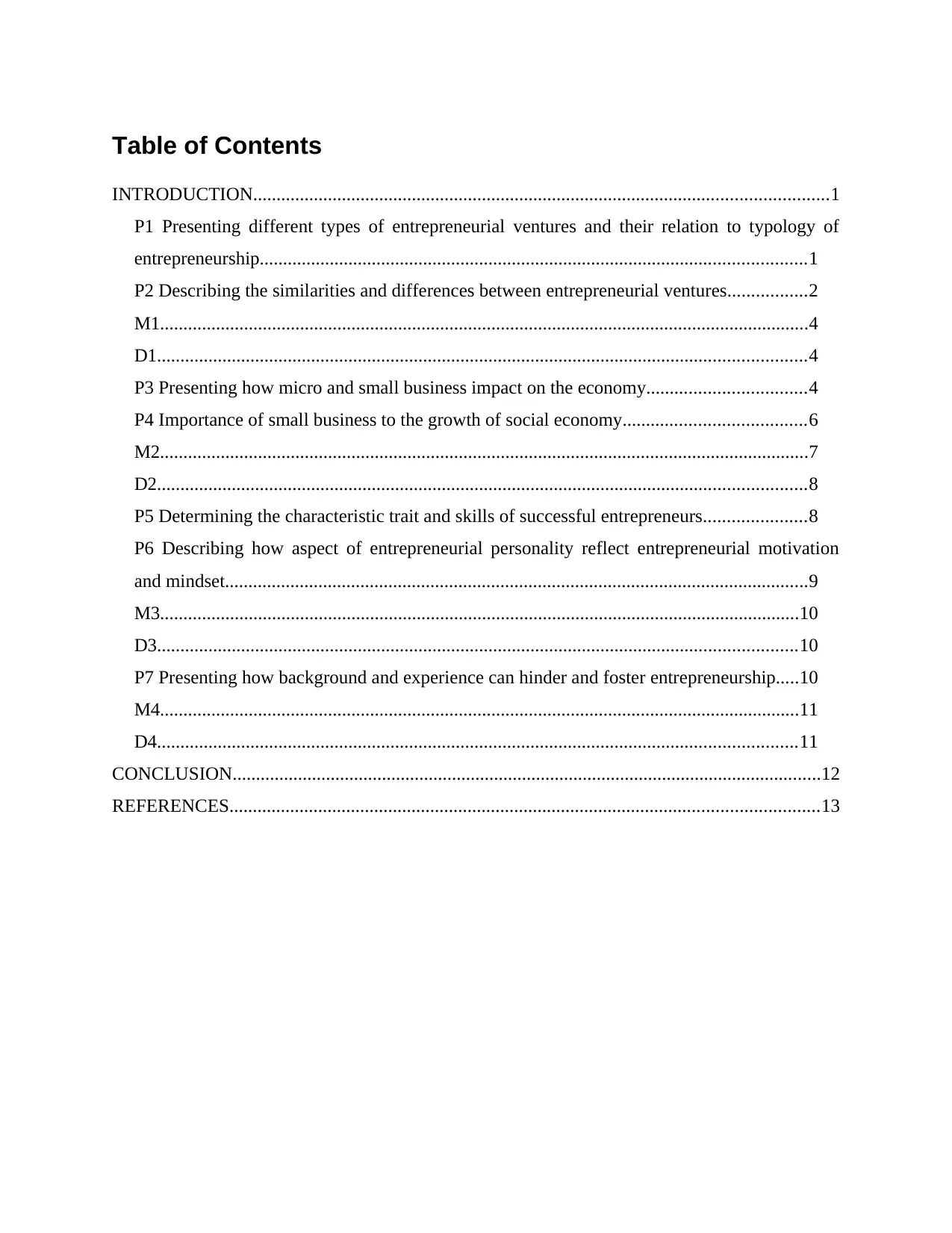
Table of Contents
INTRODUCTION...........................................................................................................................1
P1 Presenting different types of entrepreneurial ventures and their relation to typology of
entrepreneurship.....................................................................................................................1
P2 Describing the similarities and differences between entrepreneurial ventures.................2
M1...........................................................................................................................................4
D1...........................................................................................................................................4
P3 Presenting how micro and small business impact on the economy..................................4
P4 Importance of small business to the growth of social economy.......................................6
M2...........................................................................................................................................7
D2...........................................................................................................................................8
P5 Determining the characteristic trait and skills of successful entrepreneurs......................8
P6 Describing how aspect of entrepreneurial personality reflect entrepreneurial motivation
and mindset.............................................................................................................................9
M3.........................................................................................................................................10
D3.........................................................................................................................................10
P7 Presenting how background and experience can hinder and foster entrepreneurship.....10
M4.........................................................................................................................................11
D4.........................................................................................................................................11
CONCLUSION..............................................................................................................................12
REFERENCES..............................................................................................................................13
INTRODUCTION...........................................................................................................................1
P1 Presenting different types of entrepreneurial ventures and their relation to typology of
entrepreneurship.....................................................................................................................1
P2 Describing the similarities and differences between entrepreneurial ventures.................2
M1...........................................................................................................................................4
D1...........................................................................................................................................4
P3 Presenting how micro and small business impact on the economy..................................4
P4 Importance of small business to the growth of social economy.......................................6
M2...........................................................................................................................................7
D2...........................................................................................................................................8
P5 Determining the characteristic trait and skills of successful entrepreneurs......................8
P6 Describing how aspect of entrepreneurial personality reflect entrepreneurial motivation
and mindset.............................................................................................................................9
M3.........................................................................................................................................10
D3.........................................................................................................................................10
P7 Presenting how background and experience can hinder and foster entrepreneurship.....10
M4.........................................................................................................................................11
D4.........................................................................................................................................11
CONCLUSION..............................................................................................................................12
REFERENCES..............................................................................................................................13
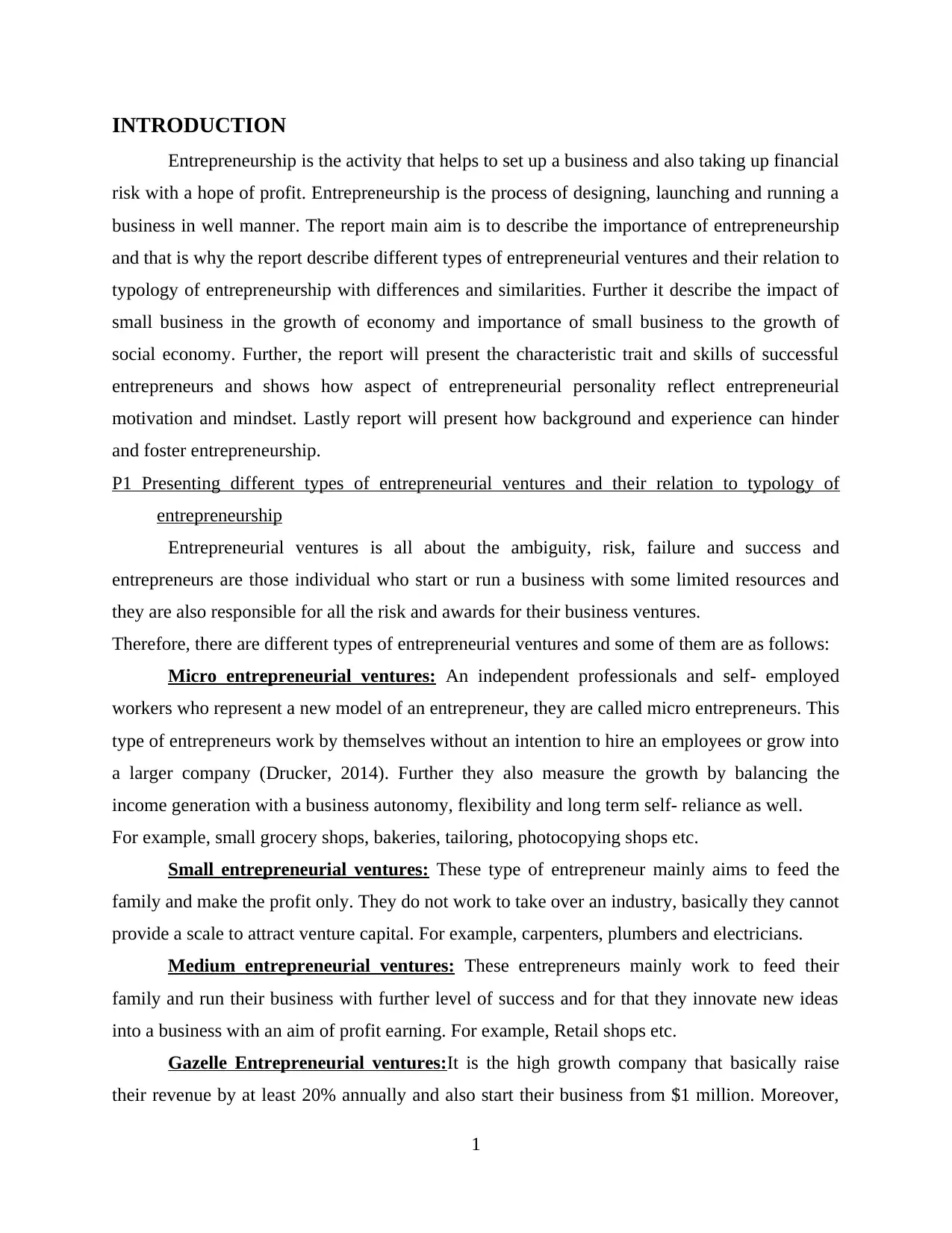
INTRODUCTION
Entrepreneurship is the activity that helps to set up a business and also taking up financial
risk with a hope of profit. Entrepreneurship is the process of designing, launching and running a
business in well manner. The report main aim is to describe the importance of entrepreneurship
and that is why the report describe different types of entrepreneurial ventures and their relation to
typology of entrepreneurship with differences and similarities. Further it describe the impact of
small business in the growth of economy and importance of small business to the growth of
social economy. Further, the report will present the characteristic trait and skills of successful
entrepreneurs and shows how aspect of entrepreneurial personality reflect entrepreneurial
motivation and mindset. Lastly report will present how background and experience can hinder
and foster entrepreneurship.
P1 Presenting different types of entrepreneurial ventures and their relation to typology of
entrepreneurship
Entrepreneurial ventures is all about the ambiguity, risk, failure and success and
entrepreneurs are those individual who start or run a business with some limited resources and
they are also responsible for all the risk and awards for their business ventures.
Therefore, there are different types of entrepreneurial ventures and some of them are as follows:
Micro entrepreneurial ventures: An independent professionals and self- employed
workers who represent a new model of an entrepreneur, they are called micro entrepreneurs. This
type of entrepreneurs work by themselves without an intention to hire an employees or grow into
a larger company (Drucker, 2014). Further they also measure the growth by balancing the
income generation with a business autonomy, flexibility and long term self- reliance as well.
For example, small grocery shops, bakeries, tailoring, photocopying shops etc.
Small entrepreneurial ventures: These type of entrepreneur mainly aims to feed the
family and make the profit only. They do not work to take over an industry, basically they cannot
provide a scale to attract venture capital. For example, carpenters, plumbers and electricians.
Medium entrepreneurial ventures: These entrepreneurs mainly work to feed their
family and run their business with further level of success and for that they innovate new ideas
into a business with an aim of profit earning. For example, Retail shops etc.
Gazelle Entrepreneurial ventures:It is the high growth company that basically raise
their revenue by at least 20% annually and also start their business from $1 million. Moreover,
1
Entrepreneurship is the activity that helps to set up a business and also taking up financial
risk with a hope of profit. Entrepreneurship is the process of designing, launching and running a
business in well manner. The report main aim is to describe the importance of entrepreneurship
and that is why the report describe different types of entrepreneurial ventures and their relation to
typology of entrepreneurship with differences and similarities. Further it describe the impact of
small business in the growth of economy and importance of small business to the growth of
social economy. Further, the report will present the characteristic trait and skills of successful
entrepreneurs and shows how aspect of entrepreneurial personality reflect entrepreneurial
motivation and mindset. Lastly report will present how background and experience can hinder
and foster entrepreneurship.
P1 Presenting different types of entrepreneurial ventures and their relation to typology of
entrepreneurship
Entrepreneurial ventures is all about the ambiguity, risk, failure and success and
entrepreneurs are those individual who start or run a business with some limited resources and
they are also responsible for all the risk and awards for their business ventures.
Therefore, there are different types of entrepreneurial ventures and some of them are as follows:
Micro entrepreneurial ventures: An independent professionals and self- employed
workers who represent a new model of an entrepreneur, they are called micro entrepreneurs. This
type of entrepreneurs work by themselves without an intention to hire an employees or grow into
a larger company (Drucker, 2014). Further they also measure the growth by balancing the
income generation with a business autonomy, flexibility and long term self- reliance as well.
For example, small grocery shops, bakeries, tailoring, photocopying shops etc.
Small entrepreneurial ventures: These type of entrepreneur mainly aims to feed the
family and make the profit only. They do not work to take over an industry, basically they cannot
provide a scale to attract venture capital. For example, carpenters, plumbers and electricians.
Medium entrepreneurial ventures: These entrepreneurs mainly work to feed their
family and run their business with further level of success and for that they innovate new ideas
into a business with an aim of profit earning. For example, Retail shops etc.
Gazelle Entrepreneurial ventures:It is the high growth company that basically raise
their revenue by at least 20% annually and also start their business from $1 million. Moreover,
1
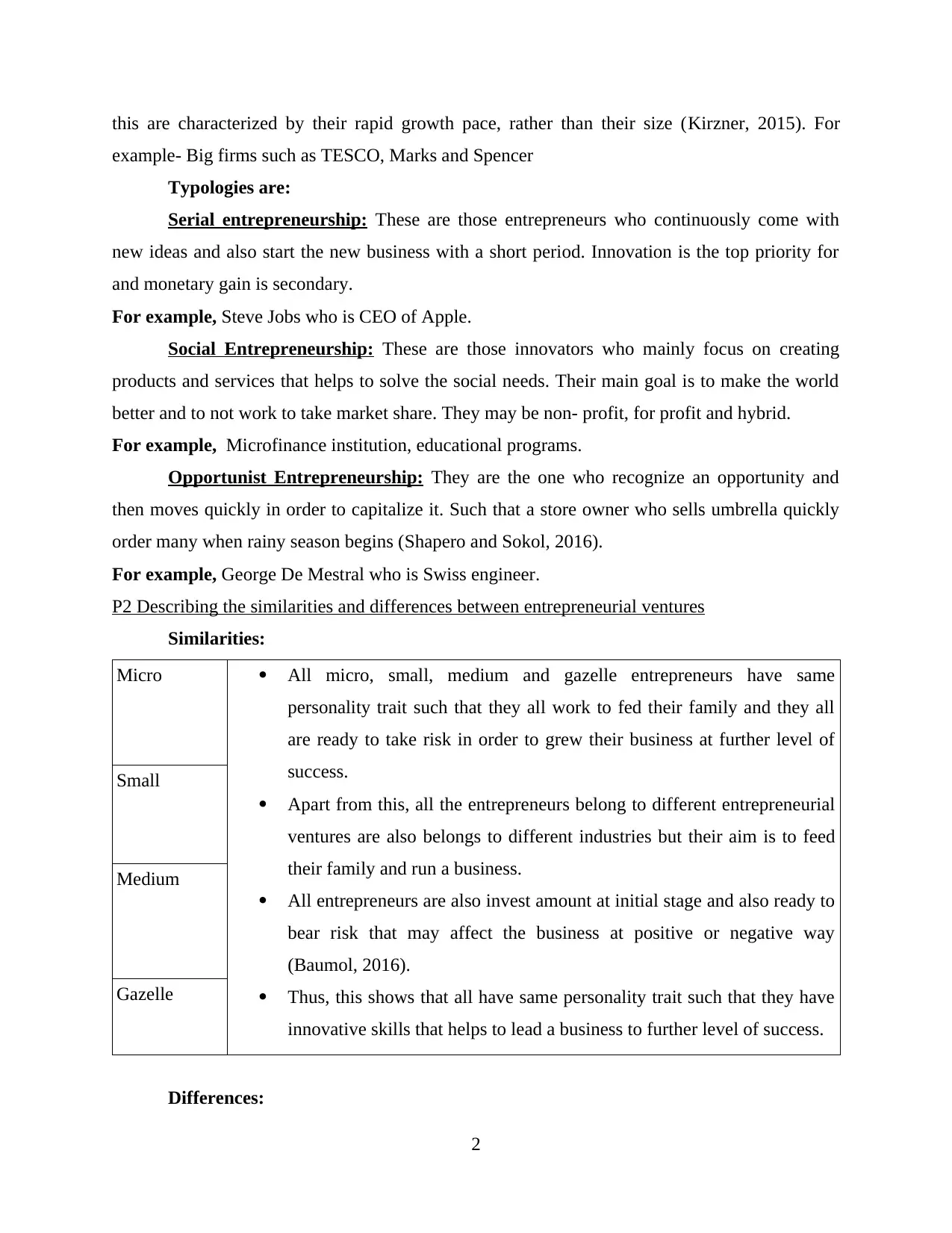
this are characterized by their rapid growth pace, rather than their size (Kirzner, 2015). For
example- Big firms such as TESCO, Marks and Spencer
Typologies are:
Serial entrepreneurship: These are those entrepreneurs who continuously come with
new ideas and also start the new business with a short period. Innovation is the top priority for
and monetary gain is secondary.
For example, Steve Jobs who is CEO of Apple.
Social Entrepreneurship: These are those innovators who mainly focus on creating
products and services that helps to solve the social needs. Their main goal is to make the world
better and to not work to take market share. They may be non- profit, for profit and hybrid.
For example, Microfinance institution, educational programs.
Opportunist Entrepreneurship: They are the one who recognize an opportunity and
then moves quickly in order to capitalize it. Such that a store owner who sells umbrella quickly
order many when rainy season begins (Shapero and Sokol, 2016).
For example, George De Mestral who is Swiss engineer.
P2 Describing the similarities and differences between entrepreneurial ventures
Similarities:
Micro All micro, small, medium and gazelle entrepreneurs have same
personality trait such that they all work to fed their family and they all
are ready to take risk in order to grew their business at further level of
success.
Apart from this, all the entrepreneurs belong to different entrepreneurial
ventures are also belongs to different industries but their aim is to feed
their family and run a business.
All entrepreneurs are also invest amount at initial stage and also ready to
bear risk that may affect the business at positive or negative way
(Baumol, 2016).
Thus, this shows that all have same personality trait such that they have
innovative skills that helps to lead a business to further level of success.
Small
Medium
Gazelle
Differences:
2
example- Big firms such as TESCO, Marks and Spencer
Typologies are:
Serial entrepreneurship: These are those entrepreneurs who continuously come with
new ideas and also start the new business with a short period. Innovation is the top priority for
and monetary gain is secondary.
For example, Steve Jobs who is CEO of Apple.
Social Entrepreneurship: These are those innovators who mainly focus on creating
products and services that helps to solve the social needs. Their main goal is to make the world
better and to not work to take market share. They may be non- profit, for profit and hybrid.
For example, Microfinance institution, educational programs.
Opportunist Entrepreneurship: They are the one who recognize an opportunity and
then moves quickly in order to capitalize it. Such that a store owner who sells umbrella quickly
order many when rainy season begins (Shapero and Sokol, 2016).
For example, George De Mestral who is Swiss engineer.
P2 Describing the similarities and differences between entrepreneurial ventures
Similarities:
Micro All micro, small, medium and gazelle entrepreneurs have same
personality trait such that they all work to fed their family and they all
are ready to take risk in order to grew their business at further level of
success.
Apart from this, all the entrepreneurs belong to different entrepreneurial
ventures are also belongs to different industries but their aim is to feed
their family and run a business.
All entrepreneurs are also invest amount at initial stage and also ready to
bear risk that may affect the business at positive or negative way
(Baumol, 2016).
Thus, this shows that all have same personality trait such that they have
innovative skills that helps to lead a business to further level of success.
Small
Medium
Gazelle
Differences:
2
Secure Best Marks with AI Grader
Need help grading? Try our AI Grader for instant feedback on your assignments.

Particulars Micro Small Medium Gazelle
Size and scope The size and
scope of micro
entrepreneurs are
quite small as
compared to
others because
they did not earn
to raise profit.
The size of small
entrepreneurship
is moderate
because it
requires less
capital investment
as compared to
others.
The scope of
Medium
entrepreneurial
venture is
growing and
many
entrepreneurs are
also invest in
these business.
These have less
scope and size as
compared to
others.
Objective Their main aim is
to create a large
scale employment
for the growth of
economy.
Their main aim is
to feed their
family by
providing good
quality of
products.
Provide better
services with an
aim to reach
higher level of
customers to
maximize the
profit (King and
Levine, 2015).
Their objective is
to earn money by
hiring variety of
employees and
provides the best
quality of
products.
Number of
employees
It does not hire
any employees
such that the
owner themselves
are owner.
It requires 3-5
employees.
It requires 40 to
100 employees.
It requires more
than 50
employees.
Orientation This is product
oriented.
This is customer
and product
oriented.
This is customer
oriented.
This is both
product and
customer oriented
(Zimmer, 2016).
Capital
investment
Requires very
small amount of
investment at
It requires approx
£5000 amount of
capital
It requires more
than around
The initial
amount invested
by gazelle is more
3
Size and scope The size and
scope of micro
entrepreneurs are
quite small as
compared to
others because
they did not earn
to raise profit.
The size of small
entrepreneurship
is moderate
because it
requires less
capital investment
as compared to
others.
The scope of
Medium
entrepreneurial
venture is
growing and
many
entrepreneurs are
also invest in
these business.
These have less
scope and size as
compared to
others.
Objective Their main aim is
to create a large
scale employment
for the growth of
economy.
Their main aim is
to feed their
family by
providing good
quality of
products.
Provide better
services with an
aim to reach
higher level of
customers to
maximize the
profit (King and
Levine, 2015).
Their objective is
to earn money by
hiring variety of
employees and
provides the best
quality of
products.
Number of
employees
It does not hire
any employees
such that the
owner themselves
are owner.
It requires 3-5
employees.
It requires 40 to
100 employees.
It requires more
than 50
employees.
Orientation This is product
oriented.
This is customer
and product
oriented.
This is customer
oriented.
This is both
product and
customer oriented
(Zimmer, 2016).
Capital
investment
Requires very
small amount of
investment at
It requires approx
£5000 amount of
capital
It requires more
than around
The initial
amount invested
by gazelle is more
3
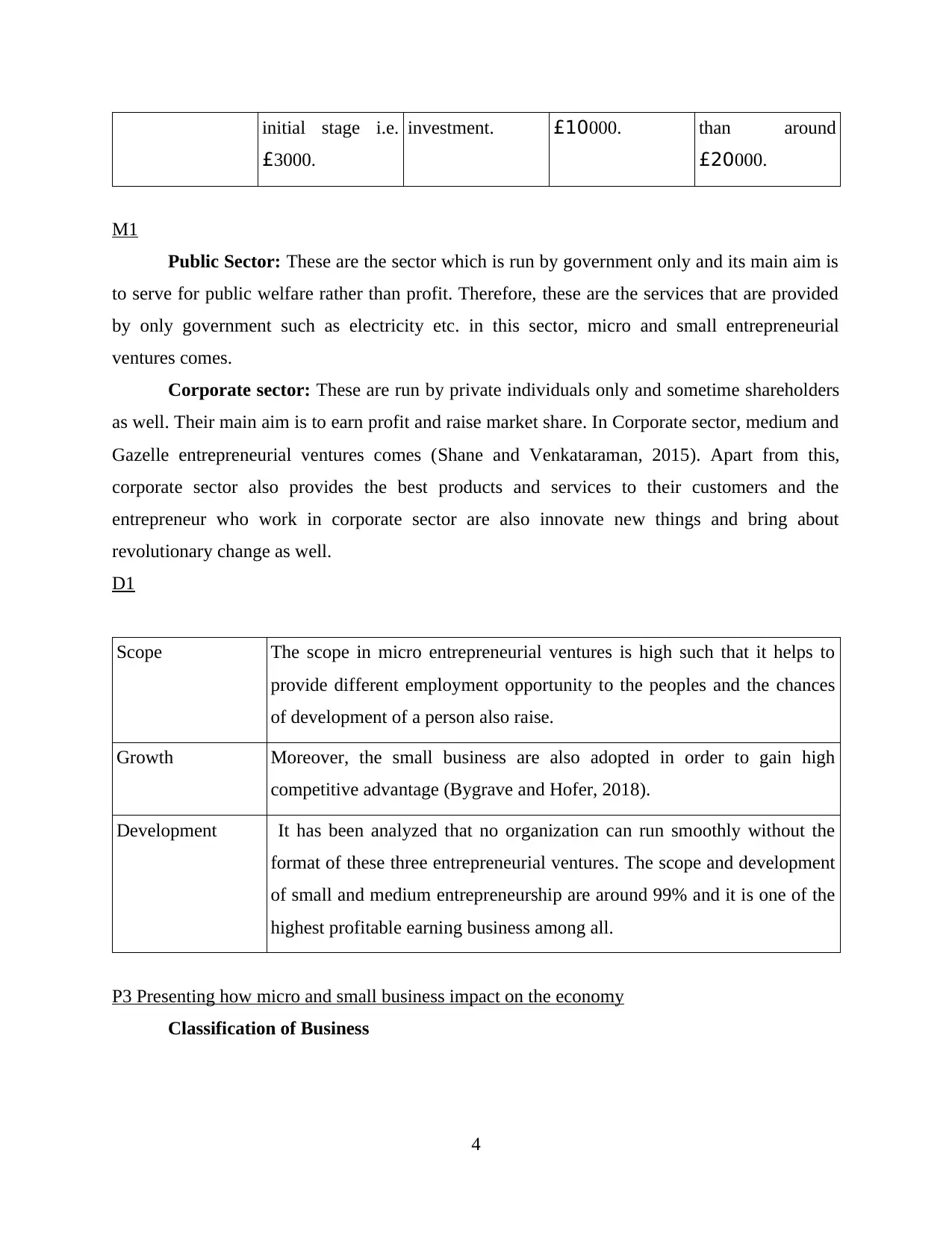
initial stage i.e.
£3000.
investment. £10000. than around
£20000.
M1
Public Sector: These are the sector which is run by government only and its main aim is
to serve for public welfare rather than profit. Therefore, these are the services that are provided
by only government such as electricity etc. in this sector, micro and small entrepreneurial
ventures comes.
Corporate sector: These are run by private individuals only and sometime shareholders
as well. Their main aim is to earn profit and raise market share. In Corporate sector, medium and
Gazelle entrepreneurial ventures comes (Shane and Venkataraman, 2015). Apart from this,
corporate sector also provides the best products and services to their customers and the
entrepreneur who work in corporate sector are also innovate new things and bring about
revolutionary change as well.
D1
Scope The scope in micro entrepreneurial ventures is high such that it helps to
provide different employment opportunity to the peoples and the chances
of development of a person also raise.
Growth Moreover, the small business are also adopted in order to gain high
competitive advantage (Bygrave and Hofer, 2018).
Development It has been analyzed that no organization can run smoothly without the
format of these three entrepreneurial ventures. The scope and development
of small and medium entrepreneurship are around 99% and it is one of the
highest profitable earning business among all.
P3 Presenting how micro and small business impact on the economy
Classification of Business
4
£3000.
investment. £10000. than around
£20000.
M1
Public Sector: These are the sector which is run by government only and its main aim is
to serve for public welfare rather than profit. Therefore, these are the services that are provided
by only government such as electricity etc. in this sector, micro and small entrepreneurial
ventures comes.
Corporate sector: These are run by private individuals only and sometime shareholders
as well. Their main aim is to earn profit and raise market share. In Corporate sector, medium and
Gazelle entrepreneurial ventures comes (Shane and Venkataraman, 2015). Apart from this,
corporate sector also provides the best products and services to their customers and the
entrepreneur who work in corporate sector are also innovate new things and bring about
revolutionary change as well.
D1
Scope The scope in micro entrepreneurial ventures is high such that it helps to
provide different employment opportunity to the peoples and the chances
of development of a person also raise.
Growth Moreover, the small business are also adopted in order to gain high
competitive advantage (Bygrave and Hofer, 2018).
Development It has been analyzed that no organization can run smoothly without the
format of these three entrepreneurial ventures. The scope and development
of small and medium entrepreneurship are around 99% and it is one of the
highest profitable earning business among all.
P3 Presenting how micro and small business impact on the economy
Classification of Business
4
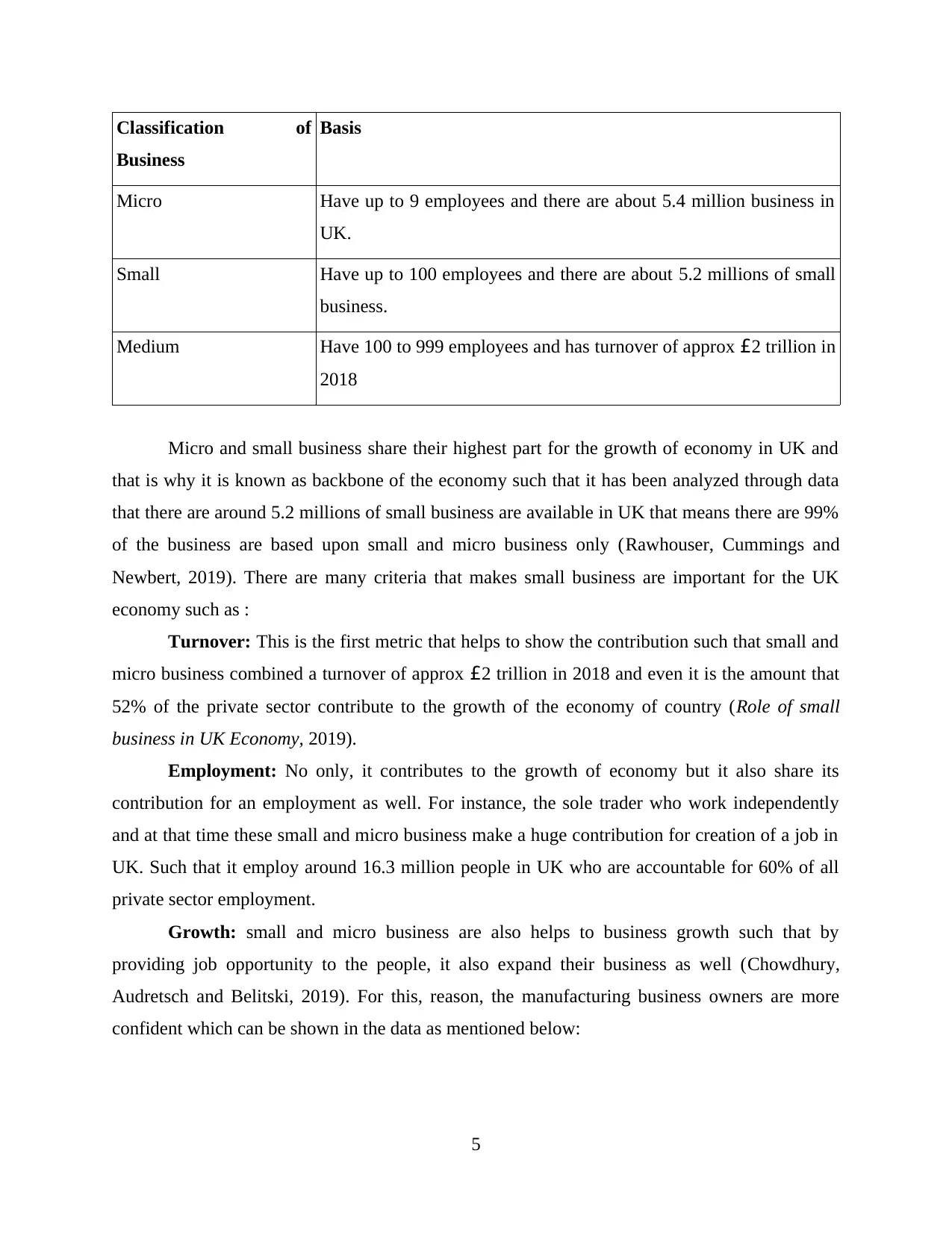
Classification of
Business
Basis
Micro Have up to 9 employees and there are about 5.4 million business in
UK.
Small Have up to 100 employees and there are about 5.2 millions of small
business.
Medium Have 100 to 999 employees and has turnover of approx £2 trillion in
2018
Micro and small business share their highest part for the growth of economy in UK and
that is why it is known as backbone of the economy such that it has been analyzed through data
that there are around 5.2 millions of small business are available in UK that means there are 99%
of the business are based upon small and micro business only (Rawhouser, Cummings and
Newbert, 2019). There are many criteria that makes small business are important for the UK
economy such as :
Turnover: This is the first metric that helps to show the contribution such that small and
micro business combined a turnover of approx £2 trillion in 2018 and even it is the amount that
52% of the private sector contribute to the growth of the economy of country (Role of small
business in UK Economy, 2019).
Employment: No only, it contributes to the growth of economy but it also share its
contribution for an employment as well. For instance, the sole trader who work independently
and at that time these small and micro business make a huge contribution for creation of a job in
UK. Such that it employ around 16.3 million people in UK who are accountable for 60% of all
private sector employment.
Growth: small and micro business are also helps to business growth such that by
providing job opportunity to the people, it also expand their business as well (Chowdhury,
Audretsch and Belitski, 2019). For this, reason, the manufacturing business owners are more
confident which can be shown in the data as mentioned below:
5
Business
Basis
Micro Have up to 9 employees and there are about 5.4 million business in
UK.
Small Have up to 100 employees and there are about 5.2 millions of small
business.
Medium Have 100 to 999 employees and has turnover of approx £2 trillion in
2018
Micro and small business share their highest part for the growth of economy in UK and
that is why it is known as backbone of the economy such that it has been analyzed through data
that there are around 5.2 millions of small business are available in UK that means there are 99%
of the business are based upon small and micro business only (Rawhouser, Cummings and
Newbert, 2019). There are many criteria that makes small business are important for the UK
economy such as :
Turnover: This is the first metric that helps to show the contribution such that small and
micro business combined a turnover of approx £2 trillion in 2018 and even it is the amount that
52% of the private sector contribute to the growth of the economy of country (Role of small
business in UK Economy, 2019).
Employment: No only, it contributes to the growth of economy but it also share its
contribution for an employment as well. For instance, the sole trader who work independently
and at that time these small and micro business make a huge contribution for creation of a job in
UK. Such that it employ around 16.3 million people in UK who are accountable for 60% of all
private sector employment.
Growth: small and micro business are also helps to business growth such that by
providing job opportunity to the people, it also expand their business as well (Chowdhury,
Audretsch and Belitski, 2019). For this, reason, the manufacturing business owners are more
confident which can be shown in the data as mentioned below:
5
Paraphrase This Document
Need a fresh take? Get an instant paraphrase of this document with our AI Paraphraser
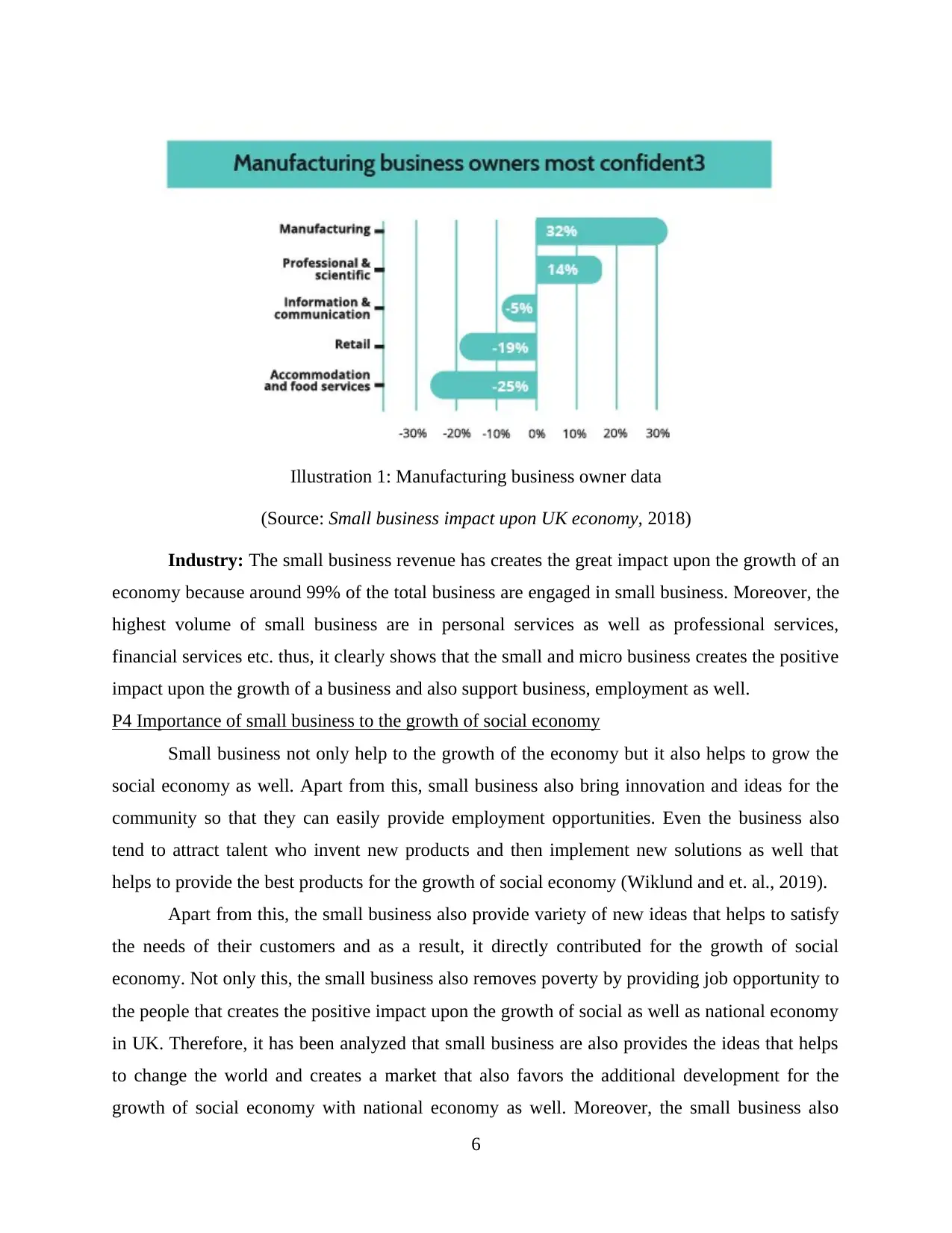
Industry: The small business revenue has creates the great impact upon the growth of an
economy because around 99% of the total business are engaged in small business. Moreover, the
highest volume of small business are in personal services as well as professional services,
financial services etc. thus, it clearly shows that the small and micro business creates the positive
impact upon the growth of a business and also support business, employment as well.
P4 Importance of small business to the growth of social economy
Small business not only help to the growth of the economy but it also helps to grow the
social economy as well. Apart from this, small business also bring innovation and ideas for the
community so that they can easily provide employment opportunities. Even the business also
tend to attract talent who invent new products and then implement new solutions as well that
helps to provide the best products for the growth of social economy (Wiklund and et. al., 2019).
Apart from this, the small business also provide variety of new ideas that helps to satisfy
the needs of their customers and as a result, it directly contributed for the growth of social
economy. Not only this, the small business also removes poverty by providing job opportunity to
the people that creates the positive impact upon the growth of social as well as national economy
in UK. Therefore, it has been analyzed that small business are also provides the ideas that helps
to change the world and creates a market that also favors the additional development for the
growth of social economy with national economy as well. Moreover, the small business also
6
Illustration 1: Manufacturing business owner data
(Source: Small business impact upon UK economy, 2018)
economy because around 99% of the total business are engaged in small business. Moreover, the
highest volume of small business are in personal services as well as professional services,
financial services etc. thus, it clearly shows that the small and micro business creates the positive
impact upon the growth of a business and also support business, employment as well.
P4 Importance of small business to the growth of social economy
Small business not only help to the growth of the economy but it also helps to grow the
social economy as well. Apart from this, small business also bring innovation and ideas for the
community so that they can easily provide employment opportunities. Even the business also
tend to attract talent who invent new products and then implement new solutions as well that
helps to provide the best products for the growth of social economy (Wiklund and et. al., 2019).
Apart from this, the small business also provide variety of new ideas that helps to satisfy
the needs of their customers and as a result, it directly contributed for the growth of social
economy. Not only this, the small business also removes poverty by providing job opportunity to
the people that creates the positive impact upon the growth of social as well as national economy
in UK. Therefore, it has been analyzed that small business are also provides the ideas that helps
to change the world and creates a market that also favors the additional development for the
growth of social economy with national economy as well. Moreover, the small business also
6
Illustration 1: Manufacturing business owner data
(Source: Small business impact upon UK economy, 2018)
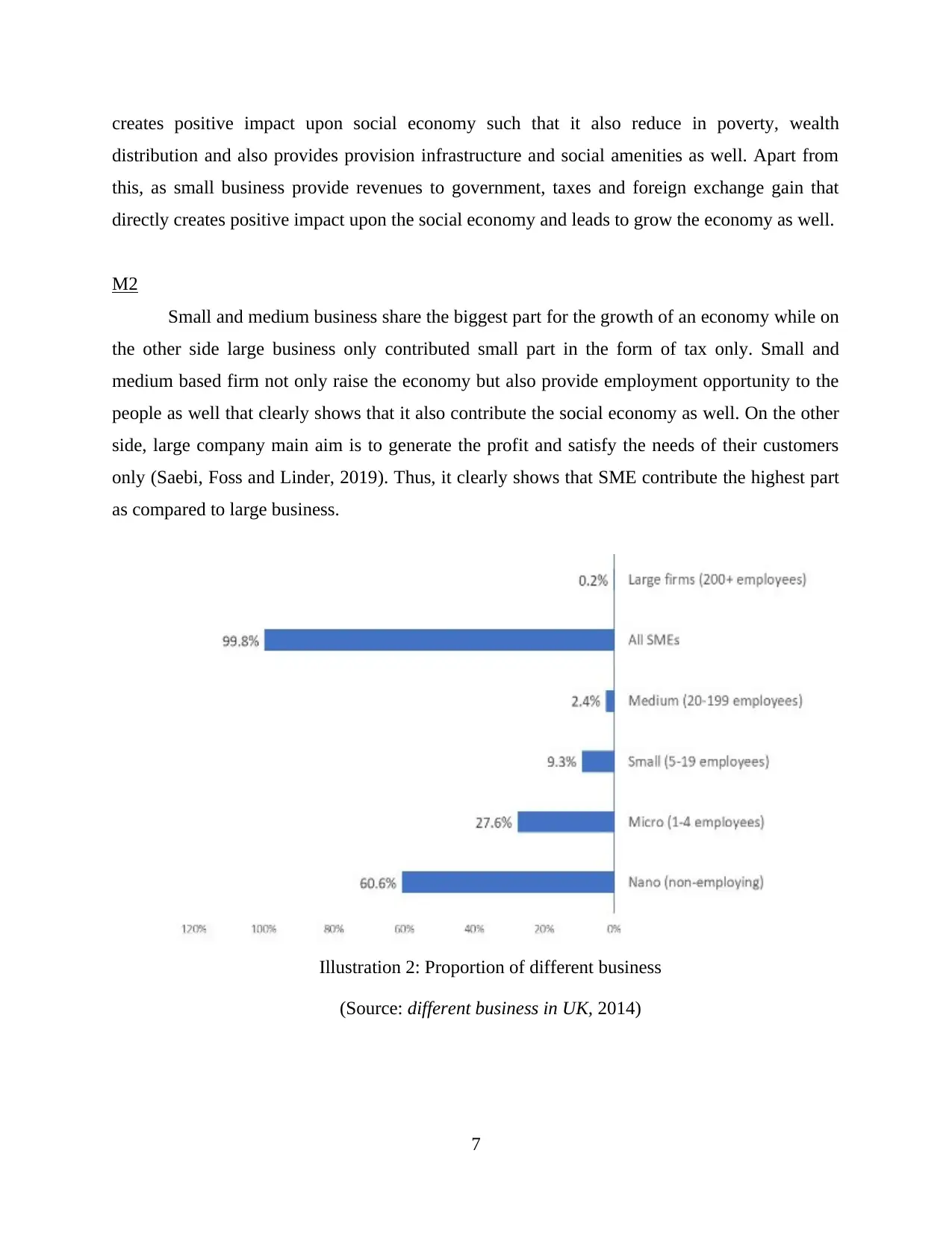
creates positive impact upon social economy such that it also reduce in poverty, wealth
distribution and also provides provision infrastructure and social amenities as well. Apart from
this, as small business provide revenues to government, taxes and foreign exchange gain that
directly creates positive impact upon the social economy and leads to grow the economy as well.
M2
Small and medium business share the biggest part for the growth of an economy while on
the other side large business only contributed small part in the form of tax only. Small and
medium based firm not only raise the economy but also provide employment opportunity to the
people as well that clearly shows that it also contribute the social economy as well. On the other
side, large company main aim is to generate the profit and satisfy the needs of their customers
only (Saebi, Foss and Linder, 2019). Thus, it clearly shows that SME contribute the highest part
as compared to large business.
7
Illustration 2: Proportion of different business
(Source: different business in UK, 2014)
distribution and also provides provision infrastructure and social amenities as well. Apart from
this, as small business provide revenues to government, taxes and foreign exchange gain that
directly creates positive impact upon the social economy and leads to grow the economy as well.
M2
Small and medium business share the biggest part for the growth of an economy while on
the other side large business only contributed small part in the form of tax only. Small and
medium based firm not only raise the economy but also provide employment opportunity to the
people as well that clearly shows that it also contribute the social economy as well. On the other
side, large company main aim is to generate the profit and satisfy the needs of their customers
only (Saebi, Foss and Linder, 2019). Thus, it clearly shows that SME contribute the highest part
as compared to large business.
7
Illustration 2: Proportion of different business
(Source: different business in UK, 2014)
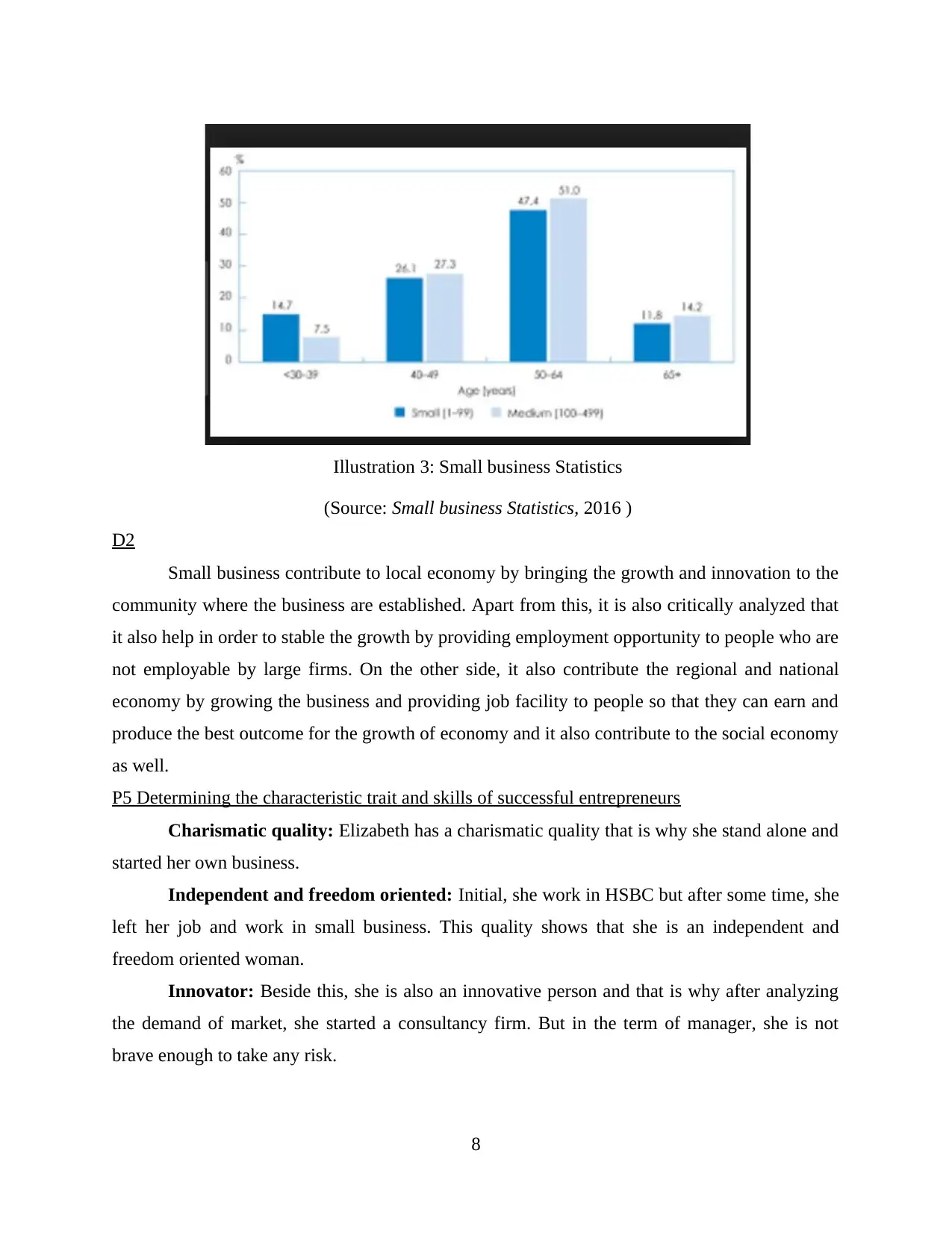
D2
Small business contribute to local economy by bringing the growth and innovation to the
community where the business are established. Apart from this, it is also critically analyzed that
it also help in order to stable the growth by providing employment opportunity to people who are
not employable by large firms. On the other side, it also contribute the regional and national
economy by growing the business and providing job facility to people so that they can earn and
produce the best outcome for the growth of economy and it also contribute to the social economy
as well.
P5 Determining the characteristic trait and skills of successful entrepreneurs
Charismatic quality: Elizabeth has a charismatic quality that is why she stand alone and
started her own business.
Independent and freedom oriented: Initial, she work in HSBC but after some time, she
left her job and work in small business. This quality shows that she is an independent and
freedom oriented woman.
Innovator: Beside this, she is also an innovative person and that is why after analyzing
the demand of market, she started a consultancy firm. But in the term of manager, she is not
brave enough to take any risk.
8
Illustration 3: Small business Statistics
(Source: Small business Statistics, 2016 )
Small business contribute to local economy by bringing the growth and innovation to the
community where the business are established. Apart from this, it is also critically analyzed that
it also help in order to stable the growth by providing employment opportunity to people who are
not employable by large firms. On the other side, it also contribute the regional and national
economy by growing the business and providing job facility to people so that they can earn and
produce the best outcome for the growth of economy and it also contribute to the social economy
as well.
P5 Determining the characteristic trait and skills of successful entrepreneurs
Charismatic quality: Elizabeth has a charismatic quality that is why she stand alone and
started her own business.
Independent and freedom oriented: Initial, she work in HSBC but after some time, she
left her job and work in small business. This quality shows that she is an independent and
freedom oriented woman.
Innovator: Beside this, she is also an innovative person and that is why after analyzing
the demand of market, she started a consultancy firm. But in the term of manager, she is not
brave enough to take any risk.
8
Illustration 3: Small business Statistics
(Source: Small business Statistics, 2016 )
Secure Best Marks with AI Grader
Need help grading? Try our AI Grader for instant feedback on your assignments.
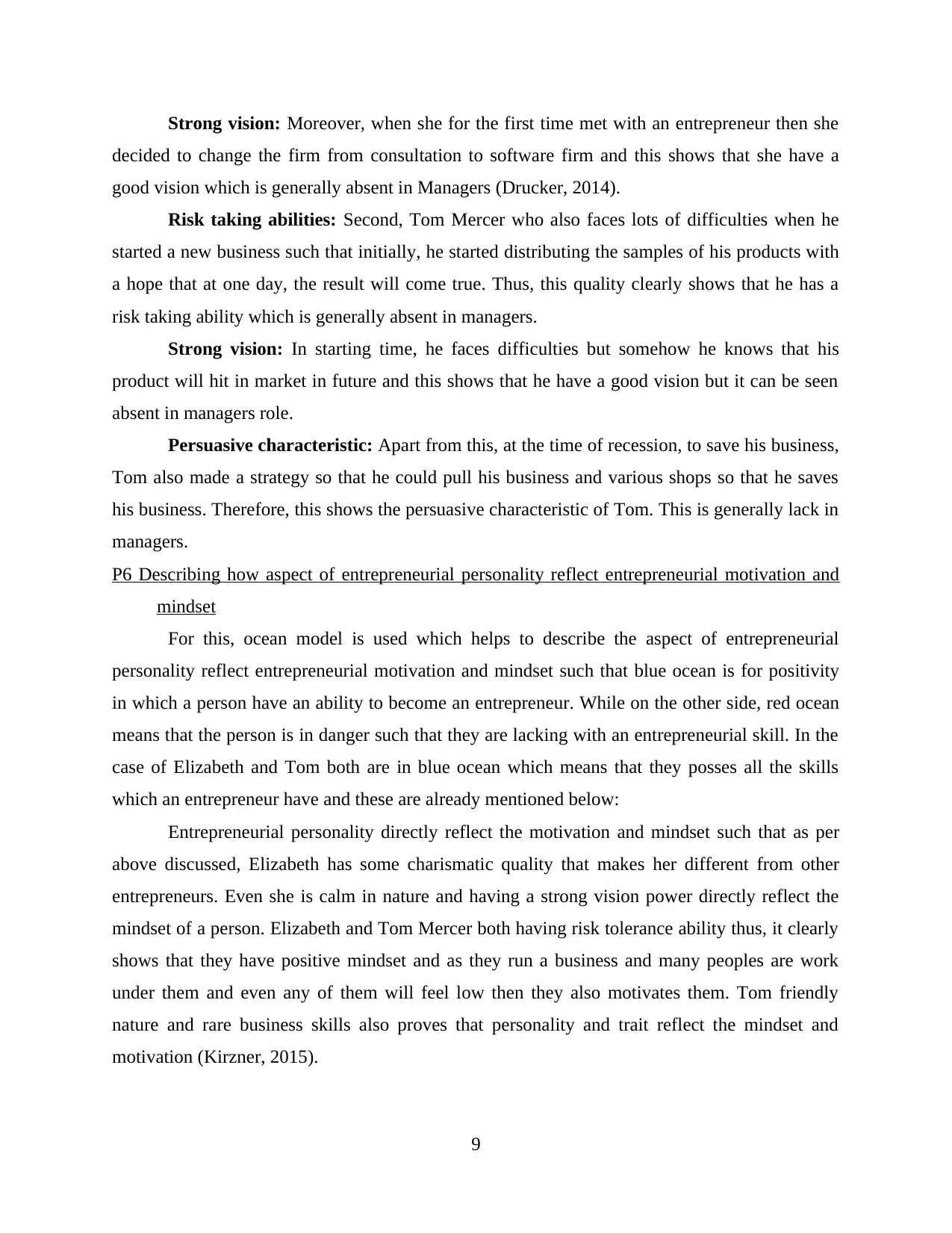
Strong vision: Moreover, when she for the first time met with an entrepreneur then she
decided to change the firm from consultation to software firm and this shows that she have a
good vision which is generally absent in Managers (Drucker, 2014).
Risk taking abilities: Second, Tom Mercer who also faces lots of difficulties when he
started a new business such that initially, he started distributing the samples of his products with
a hope that at one day, the result will come true. Thus, this quality clearly shows that he has a
risk taking ability which is generally absent in managers.
Strong vision: In starting time, he faces difficulties but somehow he knows that his
product will hit in market in future and this shows that he have a good vision but it can be seen
absent in managers role.
Persuasive characteristic: Apart from this, at the time of recession, to save his business,
Tom also made a strategy so that he could pull his business and various shops so that he saves
his business. Therefore, this shows the persuasive characteristic of Tom. This is generally lack in
managers.
P6 Describing how aspect of entrepreneurial personality reflect entrepreneurial motivation and
mindset
For this, ocean model is used which helps to describe the aspect of entrepreneurial
personality reflect entrepreneurial motivation and mindset such that blue ocean is for positivity
in which a person have an ability to become an entrepreneur. While on the other side, red ocean
means that the person is in danger such that they are lacking with an entrepreneurial skill. In the
case of Elizabeth and Tom both are in blue ocean which means that they posses all the skills
which an entrepreneur have and these are already mentioned below:
Entrepreneurial personality directly reflect the motivation and mindset such that as per
above discussed, Elizabeth has some charismatic quality that makes her different from other
entrepreneurs. Even she is calm in nature and having a strong vision power directly reflect the
mindset of a person. Elizabeth and Tom Mercer both having risk tolerance ability thus, it clearly
shows that they have positive mindset and as they run a business and many peoples are work
under them and even any of them will feel low then they also motivates them. Tom friendly
nature and rare business skills also proves that personality and trait reflect the mindset and
motivation (Kirzner, 2015).
9
decided to change the firm from consultation to software firm and this shows that she have a
good vision which is generally absent in Managers (Drucker, 2014).
Risk taking abilities: Second, Tom Mercer who also faces lots of difficulties when he
started a new business such that initially, he started distributing the samples of his products with
a hope that at one day, the result will come true. Thus, this quality clearly shows that he has a
risk taking ability which is generally absent in managers.
Strong vision: In starting time, he faces difficulties but somehow he knows that his
product will hit in market in future and this shows that he have a good vision but it can be seen
absent in managers role.
Persuasive characteristic: Apart from this, at the time of recession, to save his business,
Tom also made a strategy so that he could pull his business and various shops so that he saves
his business. Therefore, this shows the persuasive characteristic of Tom. This is generally lack in
managers.
P6 Describing how aspect of entrepreneurial personality reflect entrepreneurial motivation and
mindset
For this, ocean model is used which helps to describe the aspect of entrepreneurial
personality reflect entrepreneurial motivation and mindset such that blue ocean is for positivity
in which a person have an ability to become an entrepreneur. While on the other side, red ocean
means that the person is in danger such that they are lacking with an entrepreneurial skill. In the
case of Elizabeth and Tom both are in blue ocean which means that they posses all the skills
which an entrepreneur have and these are already mentioned below:
Entrepreneurial personality directly reflect the motivation and mindset such that as per
above discussed, Elizabeth has some charismatic quality that makes her different from other
entrepreneurs. Even she is calm in nature and having a strong vision power directly reflect the
mindset of a person. Elizabeth and Tom Mercer both having risk tolerance ability thus, it clearly
shows that they have positive mindset and as they run a business and many peoples are work
under them and even any of them will feel low then they also motivates them. Tom friendly
nature and rare business skills also proves that personality and trait reflect the mindset and
motivation (Kirzner, 2015).
9
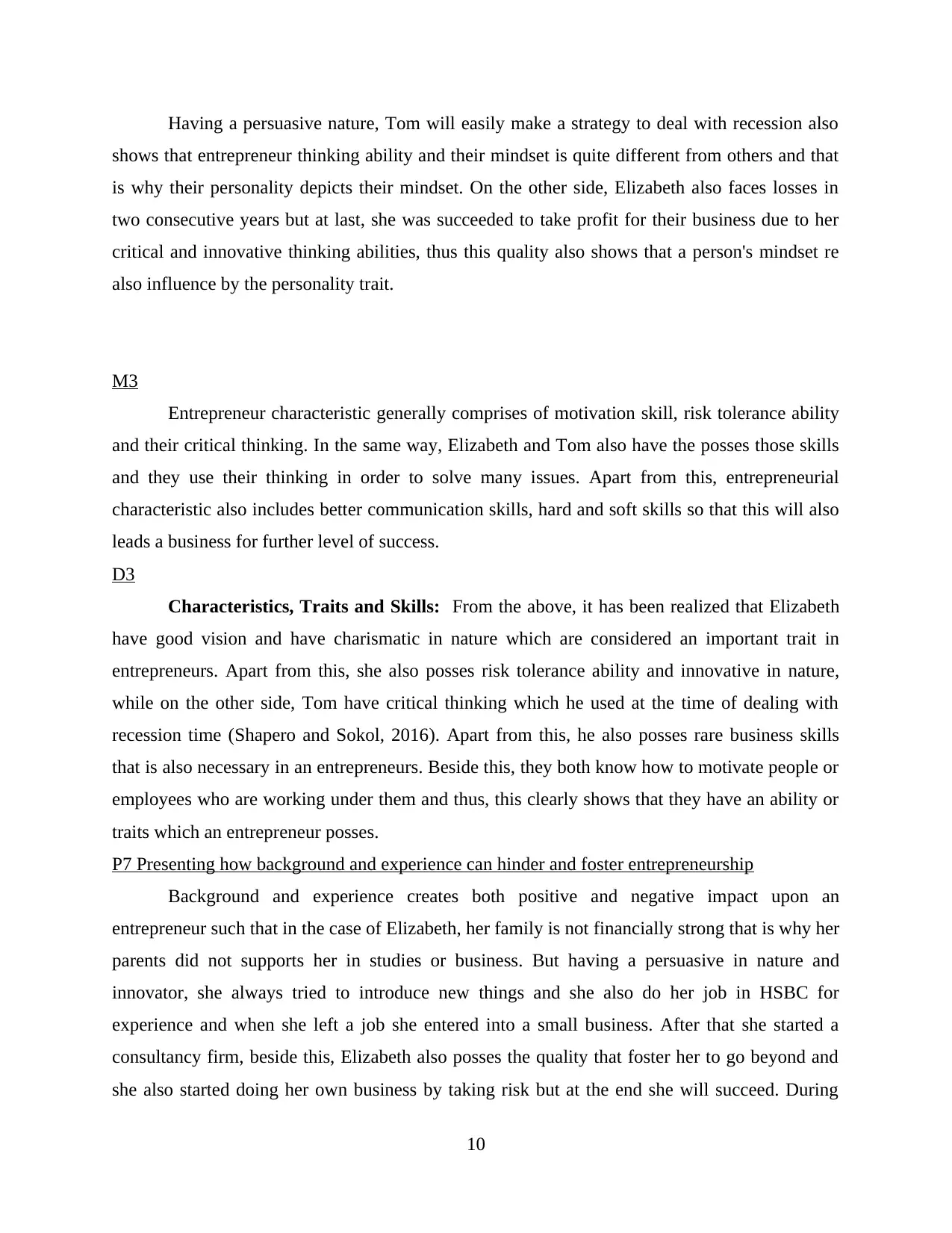
Having a persuasive nature, Tom will easily make a strategy to deal with recession also
shows that entrepreneur thinking ability and their mindset is quite different from others and that
is why their personality depicts their mindset. On the other side, Elizabeth also faces losses in
two consecutive years but at last, she was succeeded to take profit for their business due to her
critical and innovative thinking abilities, thus this quality also shows that a person's mindset re
also influence by the personality trait.
M3
Entrepreneur characteristic generally comprises of motivation skill, risk tolerance ability
and their critical thinking. In the same way, Elizabeth and Tom also have the posses those skills
and they use their thinking in order to solve many issues. Apart from this, entrepreneurial
characteristic also includes better communication skills, hard and soft skills so that this will also
leads a business for further level of success.
D3
Characteristics, Traits and Skills: From the above, it has been realized that Elizabeth
have good vision and have charismatic in nature which are considered an important trait in
entrepreneurs. Apart from this, she also posses risk tolerance ability and innovative in nature,
while on the other side, Tom have critical thinking which he used at the time of dealing with
recession time (Shapero and Sokol, 2016). Apart from this, he also posses rare business skills
that is also necessary in an entrepreneurs. Beside this, they both know how to motivate people or
employees who are working under them and thus, this clearly shows that they have an ability or
traits which an entrepreneur posses.
P7 Presenting how background and experience can hinder and foster entrepreneurship
Background and experience creates both positive and negative impact upon an
entrepreneur such that in the case of Elizabeth, her family is not financially strong that is why her
parents did not supports her in studies or business. But having a persuasive in nature and
innovator, she always tried to introduce new things and she also do her job in HSBC for
experience and when she left a job she entered into a small business. After that she started a
consultancy firm, beside this, Elizabeth also posses the quality that foster her to go beyond and
she also started doing her own business by taking risk but at the end she will succeed. During
10
shows that entrepreneur thinking ability and their mindset is quite different from others and that
is why their personality depicts their mindset. On the other side, Elizabeth also faces losses in
two consecutive years but at last, she was succeeded to take profit for their business due to her
critical and innovative thinking abilities, thus this quality also shows that a person's mindset re
also influence by the personality trait.
M3
Entrepreneur characteristic generally comprises of motivation skill, risk tolerance ability
and their critical thinking. In the same way, Elizabeth and Tom also have the posses those skills
and they use their thinking in order to solve many issues. Apart from this, entrepreneurial
characteristic also includes better communication skills, hard and soft skills so that this will also
leads a business for further level of success.
D3
Characteristics, Traits and Skills: From the above, it has been realized that Elizabeth
have good vision and have charismatic in nature which are considered an important trait in
entrepreneurs. Apart from this, she also posses risk tolerance ability and innovative in nature,
while on the other side, Tom have critical thinking which he used at the time of dealing with
recession time (Shapero and Sokol, 2016). Apart from this, he also posses rare business skills
that is also necessary in an entrepreneurs. Beside this, they both know how to motivate people or
employees who are working under them and thus, this clearly shows that they have an ability or
traits which an entrepreneur posses.
P7 Presenting how background and experience can hinder and foster entrepreneurship
Background and experience creates both positive and negative impact upon an
entrepreneur such that in the case of Elizabeth, her family is not financially strong that is why her
parents did not supports her in studies or business. But having a persuasive in nature and
innovator, she always tried to introduce new things and she also do her job in HSBC for
experience and when she left a job she entered into a small business. After that she started a
consultancy firm, beside this, Elizabeth also posses the quality that foster her to go beyond and
she also started doing her own business by taking risk but at the end she will succeed. During
10
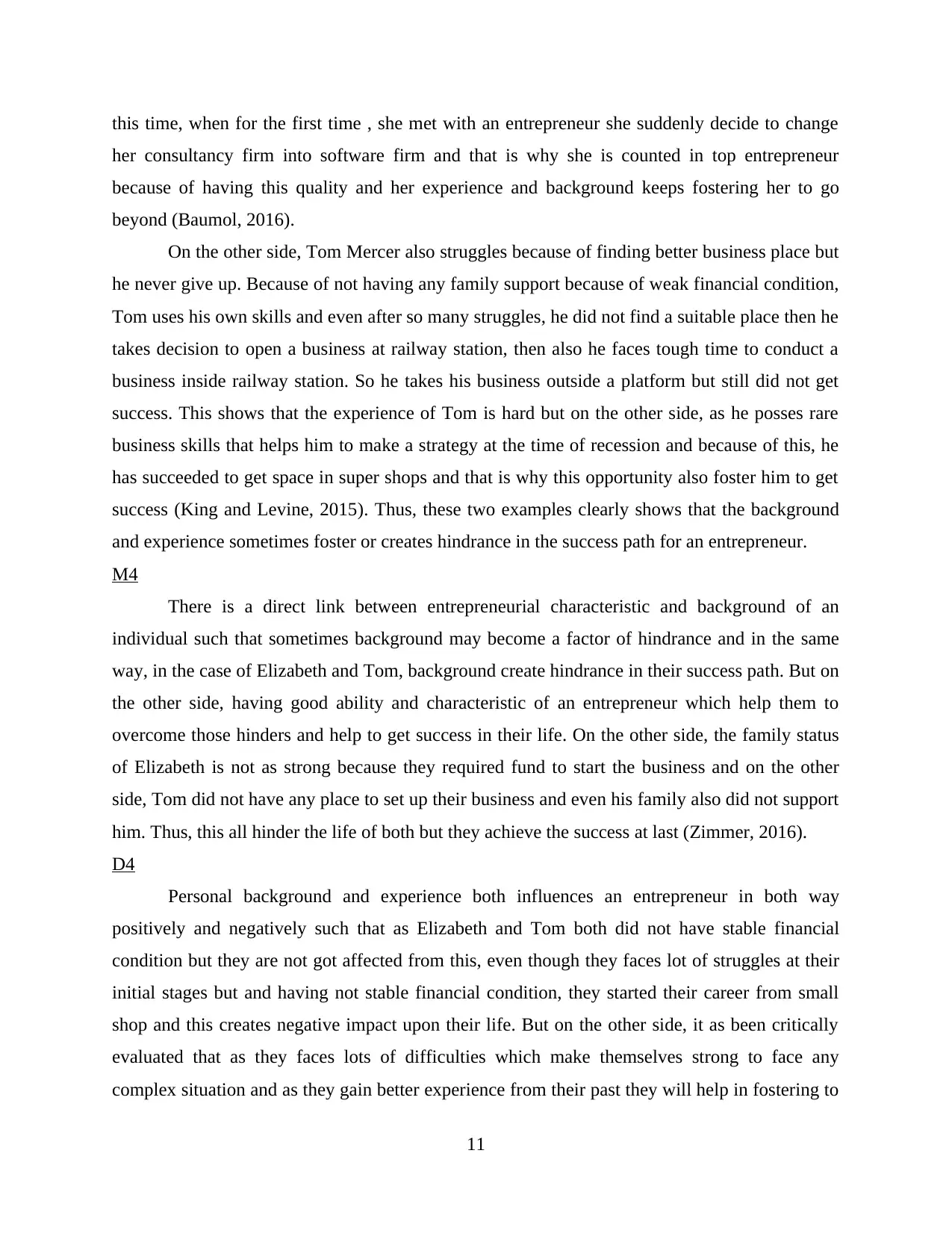
this time, when for the first time , she met with an entrepreneur she suddenly decide to change
her consultancy firm into software firm and that is why she is counted in top entrepreneur
because of having this quality and her experience and background keeps fostering her to go
beyond (Baumol, 2016).
On the other side, Tom Mercer also struggles because of finding better business place but
he never give up. Because of not having any family support because of weak financial condition,
Tom uses his own skills and even after so many struggles, he did not find a suitable place then he
takes decision to open a business at railway station, then also he faces tough time to conduct a
business inside railway station. So he takes his business outside a platform but still did not get
success. This shows that the experience of Tom is hard but on the other side, as he posses rare
business skills that helps him to make a strategy at the time of recession and because of this, he
has succeeded to get space in super shops and that is why this opportunity also foster him to get
success (King and Levine, 2015). Thus, these two examples clearly shows that the background
and experience sometimes foster or creates hindrance in the success path for an entrepreneur.
M4
There is a direct link between entrepreneurial characteristic and background of an
individual such that sometimes background may become a factor of hindrance and in the same
way, in the case of Elizabeth and Tom, background create hindrance in their success path. But on
the other side, having good ability and characteristic of an entrepreneur which help them to
overcome those hinders and help to get success in their life. On the other side, the family status
of Elizabeth is not as strong because they required fund to start the business and on the other
side, Tom did not have any place to set up their business and even his family also did not support
him. Thus, this all hinder the life of both but they achieve the success at last (Zimmer, 2016).
D4
Personal background and experience both influences an entrepreneur in both way
positively and negatively such that as Elizabeth and Tom both did not have stable financial
condition but they are not got affected from this, even though they faces lot of struggles at their
initial stages but and having not stable financial condition, they started their career from small
shop and this creates negative impact upon their life. But on the other side, it as been critically
evaluated that as they faces lots of difficulties which make themselves strong to face any
complex situation and as they gain better experience from their past they will help in fostering to
11
her consultancy firm into software firm and that is why she is counted in top entrepreneur
because of having this quality and her experience and background keeps fostering her to go
beyond (Baumol, 2016).
On the other side, Tom Mercer also struggles because of finding better business place but
he never give up. Because of not having any family support because of weak financial condition,
Tom uses his own skills and even after so many struggles, he did not find a suitable place then he
takes decision to open a business at railway station, then also he faces tough time to conduct a
business inside railway station. So he takes his business outside a platform but still did not get
success. This shows that the experience of Tom is hard but on the other side, as he posses rare
business skills that helps him to make a strategy at the time of recession and because of this, he
has succeeded to get space in super shops and that is why this opportunity also foster him to get
success (King and Levine, 2015). Thus, these two examples clearly shows that the background
and experience sometimes foster or creates hindrance in the success path for an entrepreneur.
M4
There is a direct link between entrepreneurial characteristic and background of an
individual such that sometimes background may become a factor of hindrance and in the same
way, in the case of Elizabeth and Tom, background create hindrance in their success path. But on
the other side, having good ability and characteristic of an entrepreneur which help them to
overcome those hinders and help to get success in their life. On the other side, the family status
of Elizabeth is not as strong because they required fund to start the business and on the other
side, Tom did not have any place to set up their business and even his family also did not support
him. Thus, this all hinder the life of both but they achieve the success at last (Zimmer, 2016).
D4
Personal background and experience both influences an entrepreneur in both way
positively and negatively such that as Elizabeth and Tom both did not have stable financial
condition but they are not got affected from this, even though they faces lot of struggles at their
initial stages but and having not stable financial condition, they started their career from small
shop and this creates negative impact upon their life. But on the other side, it as been critically
evaluated that as they faces lots of difficulties which make themselves strong to face any
complex situation and as they gain better experience from their past they will help in fostering to
11
Paraphrase This Document
Need a fresh take? Get an instant paraphrase of this document with our AI Paraphraser
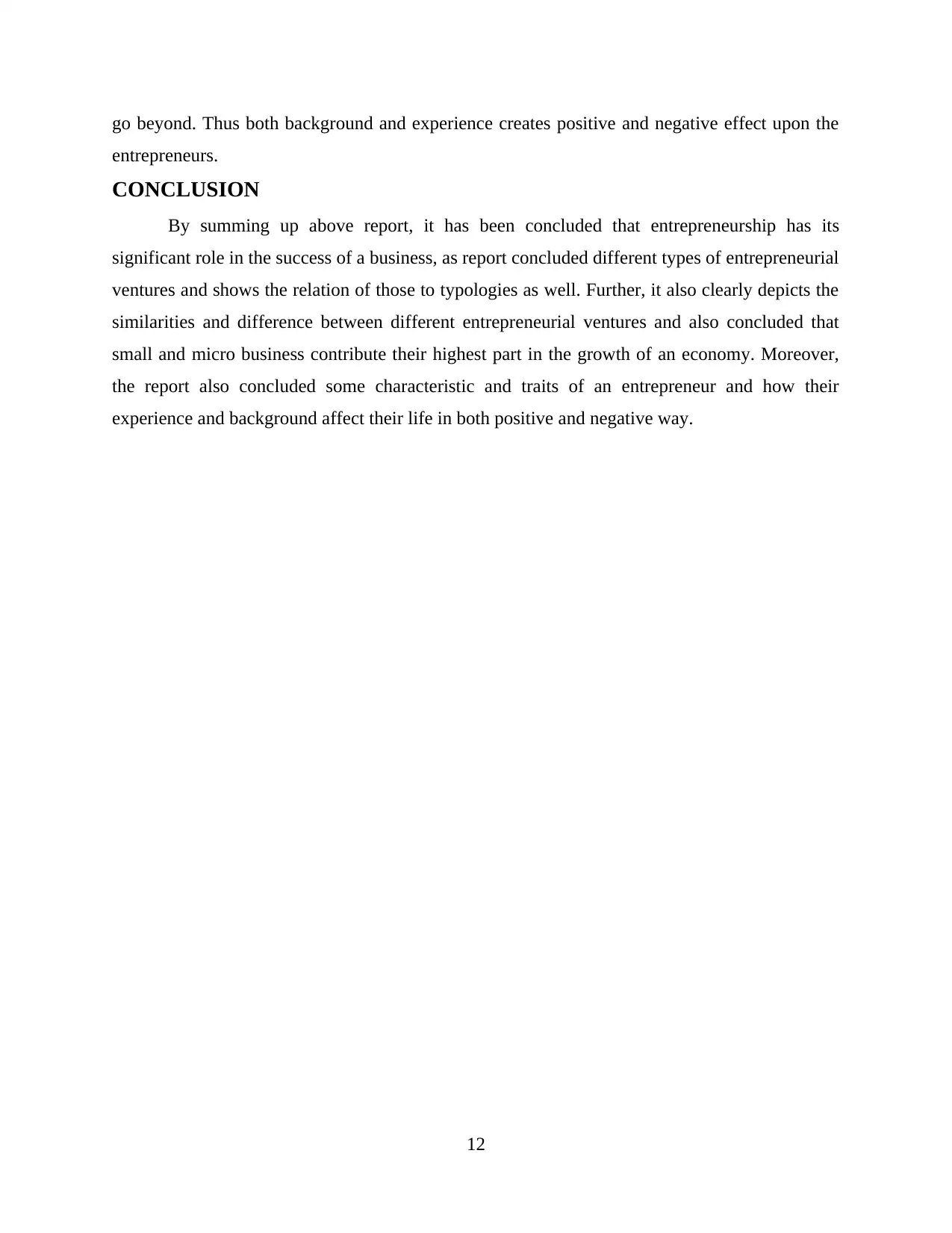
go beyond. Thus both background and experience creates positive and negative effect upon the
entrepreneurs.
CONCLUSION
By summing up above report, it has been concluded that entrepreneurship has its
significant role in the success of a business, as report concluded different types of entrepreneurial
ventures and shows the relation of those to typologies as well. Further, it also clearly depicts the
similarities and difference between different entrepreneurial ventures and also concluded that
small and micro business contribute their highest part in the growth of an economy. Moreover,
the report also concluded some characteristic and traits of an entrepreneur and how their
experience and background affect their life in both positive and negative way.
12
entrepreneurs.
CONCLUSION
By summing up above report, it has been concluded that entrepreneurship has its
significant role in the success of a business, as report concluded different types of entrepreneurial
ventures and shows the relation of those to typologies as well. Further, it also clearly depicts the
similarities and difference between different entrepreneurial ventures and also concluded that
small and micro business contribute their highest part in the growth of an economy. Moreover,
the report also concluded some characteristic and traits of an entrepreneur and how their
experience and background affect their life in both positive and negative way.
12
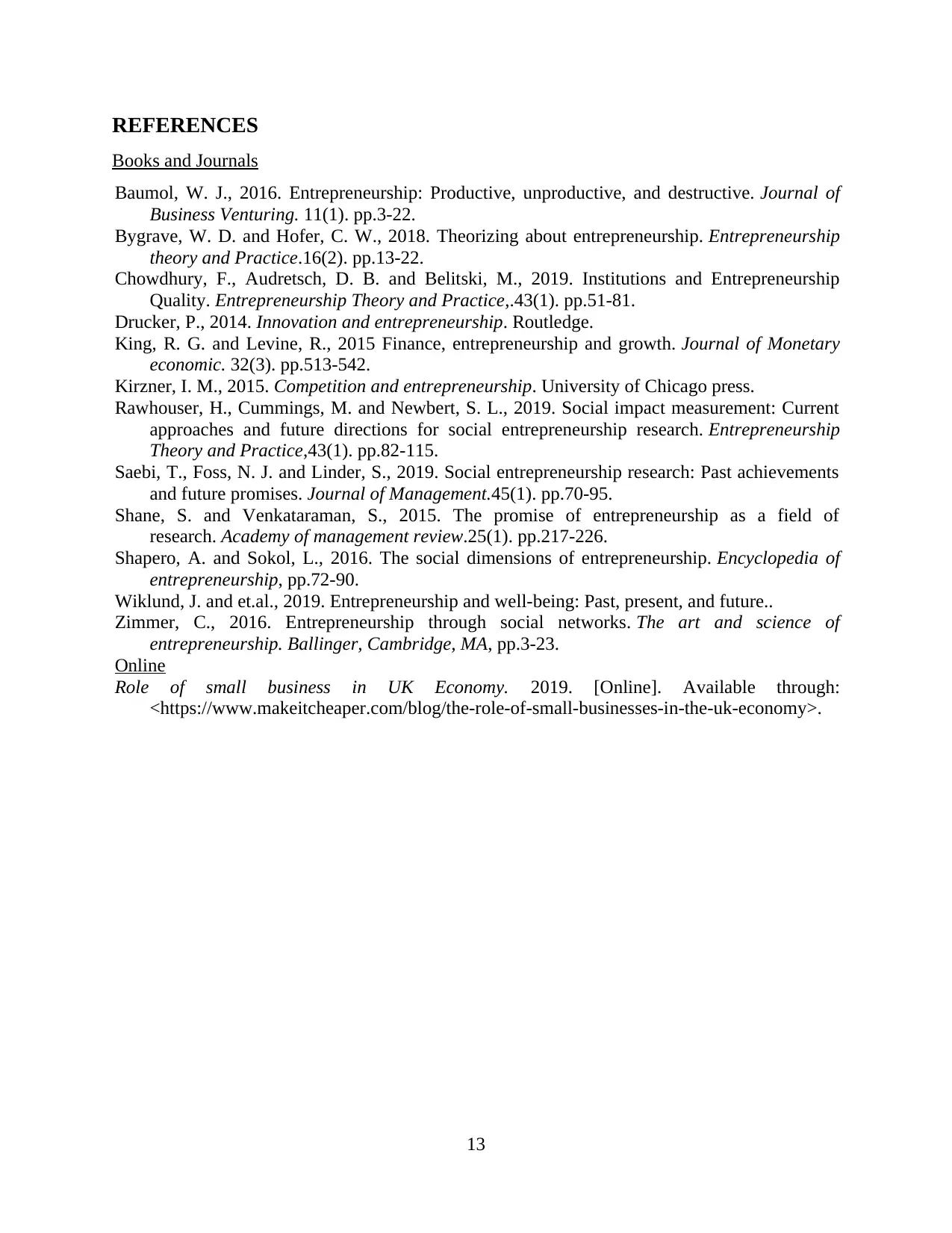
REFERENCES
Books and Journals
Baumol, W. J., 2016. Entrepreneurship: Productive, unproductive, and destructive. Journal of
Business Venturing. 11(1). pp.3-22.
Bygrave, W. D. and Hofer, C. W., 2018. Theorizing about entrepreneurship. Entrepreneurship
theory and Practice.16(2). pp.13-22.
Chowdhury, F., Audretsch, D. B. and Belitski, M., 2019. Institutions and Entrepreneurship
Quality. Entrepreneurship Theory and Practice,.43(1). pp.51-81.
Drucker, P., 2014. Innovation and entrepreneurship. Routledge.
King, R. G. and Levine, R., 2015 Finance, entrepreneurship and growth. Journal of Monetary
economic. 32(3). pp.513-542.
Kirzner, I. M., 2015. Competition and entrepreneurship. University of Chicago press.
Rawhouser, H., Cummings, M. and Newbert, S. L., 2019. Social impact measurement: Current
approaches and future directions for social entrepreneurship research. Entrepreneurship
Theory and Practice,43(1). pp.82-115.
Saebi, T., Foss, N. J. and Linder, S., 2019. Social entrepreneurship research: Past achievements
and future promises. Journal of Management.45(1). pp.70-95.
Shane, S. and Venkataraman, S., 2015. The promise of entrepreneurship as a field of
research. Academy of management review.25(1). pp.217-226.
Shapero, A. and Sokol, L., 2016. The social dimensions of entrepreneurship. Encyclopedia of
entrepreneurship, pp.72-90.
Wiklund, J. and et.al., 2019. Entrepreneurship and well-being: Past, present, and future..
Zimmer, C., 2016. Entrepreneurship through social networks. The art and science of
entrepreneurship. Ballinger, Cambridge, MA, pp.3-23.
Online
Role of small business in UK Economy. 2019. [Online]. Available through:
<https://www.makeitcheaper.com/blog/the-role-of-small-businesses-in-the-uk-economy>.
13
Books and Journals
Baumol, W. J., 2016. Entrepreneurship: Productive, unproductive, and destructive. Journal of
Business Venturing. 11(1). pp.3-22.
Bygrave, W. D. and Hofer, C. W., 2018. Theorizing about entrepreneurship. Entrepreneurship
theory and Practice.16(2). pp.13-22.
Chowdhury, F., Audretsch, D. B. and Belitski, M., 2019. Institutions and Entrepreneurship
Quality. Entrepreneurship Theory and Practice,.43(1). pp.51-81.
Drucker, P., 2014. Innovation and entrepreneurship. Routledge.
King, R. G. and Levine, R., 2015 Finance, entrepreneurship and growth. Journal of Monetary
economic. 32(3). pp.513-542.
Kirzner, I. M., 2015. Competition and entrepreneurship. University of Chicago press.
Rawhouser, H., Cummings, M. and Newbert, S. L., 2019. Social impact measurement: Current
approaches and future directions for social entrepreneurship research. Entrepreneurship
Theory and Practice,43(1). pp.82-115.
Saebi, T., Foss, N. J. and Linder, S., 2019. Social entrepreneurship research: Past achievements
and future promises. Journal of Management.45(1). pp.70-95.
Shane, S. and Venkataraman, S., 2015. The promise of entrepreneurship as a field of
research. Academy of management review.25(1). pp.217-226.
Shapero, A. and Sokol, L., 2016. The social dimensions of entrepreneurship. Encyclopedia of
entrepreneurship, pp.72-90.
Wiklund, J. and et.al., 2019. Entrepreneurship and well-being: Past, present, and future..
Zimmer, C., 2016. Entrepreneurship through social networks. The art and science of
entrepreneurship. Ballinger, Cambridge, MA, pp.3-23.
Online
Role of small business in UK Economy. 2019. [Online]. Available through:
<https://www.makeitcheaper.com/blog/the-role-of-small-businesses-in-the-uk-economy>.
13
1 out of 15
Related Documents
Your All-in-One AI-Powered Toolkit for Academic Success.
+13062052269
info@desklib.com
Available 24*7 on WhatsApp / Email
![[object Object]](/_next/static/media/star-bottom.7253800d.svg)
Unlock your academic potential
© 2024 | Zucol Services PVT LTD | All rights reserved.





